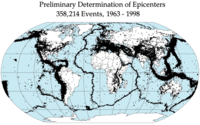
Photo from wikipedia
A complete earthquake catalog is essential to understand earthquake nucleation and fault stress. Following the Gutenberg–Richter law, smaller, unseen seismic events dominate the earthquake catalog and are invaluable for revealing… Click to show full abstract
A complete earthquake catalog is essential to understand earthquake nucleation and fault stress. Following the Gutenberg–Richter law, smaller, unseen seismic events dominate the earthquake catalog and are invaluable for revealing the fault state. The published earthquake catalogs, however, typically miss a significant number of small earthquakes. Part of the reason is due to a limitation of conventional algorithms, which can hardly extract small signals from background noise in a reliable and efficient way. To address this challenge, we utilized a machine learning method and developed new models to detect and locate seismic events. These models are efficient in processing a large amount of seismic data and extracting small seismic events. We applied our method to seismic data in Oklahoma, United States, and detected ∼14 times more earthquakes compared with the standard Oklahoma Geological Survey catalog. The rich information contained in the new catalog helps better understand the induced earthquakes in Oklahoma.
Journal Title: Bulletin of the Seismological Society of America
Year Published: 2022
Link to full text (if available)
Share on Social Media: Sign Up to like & get
recommendations!